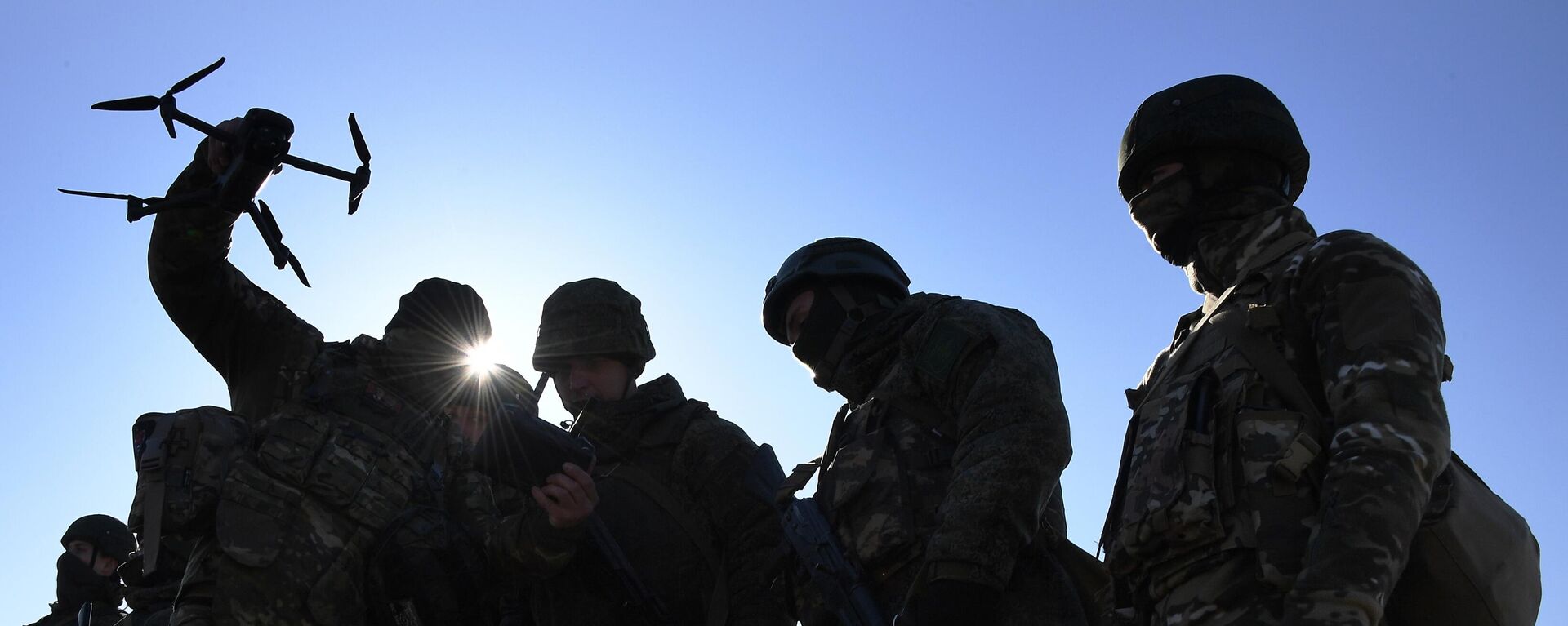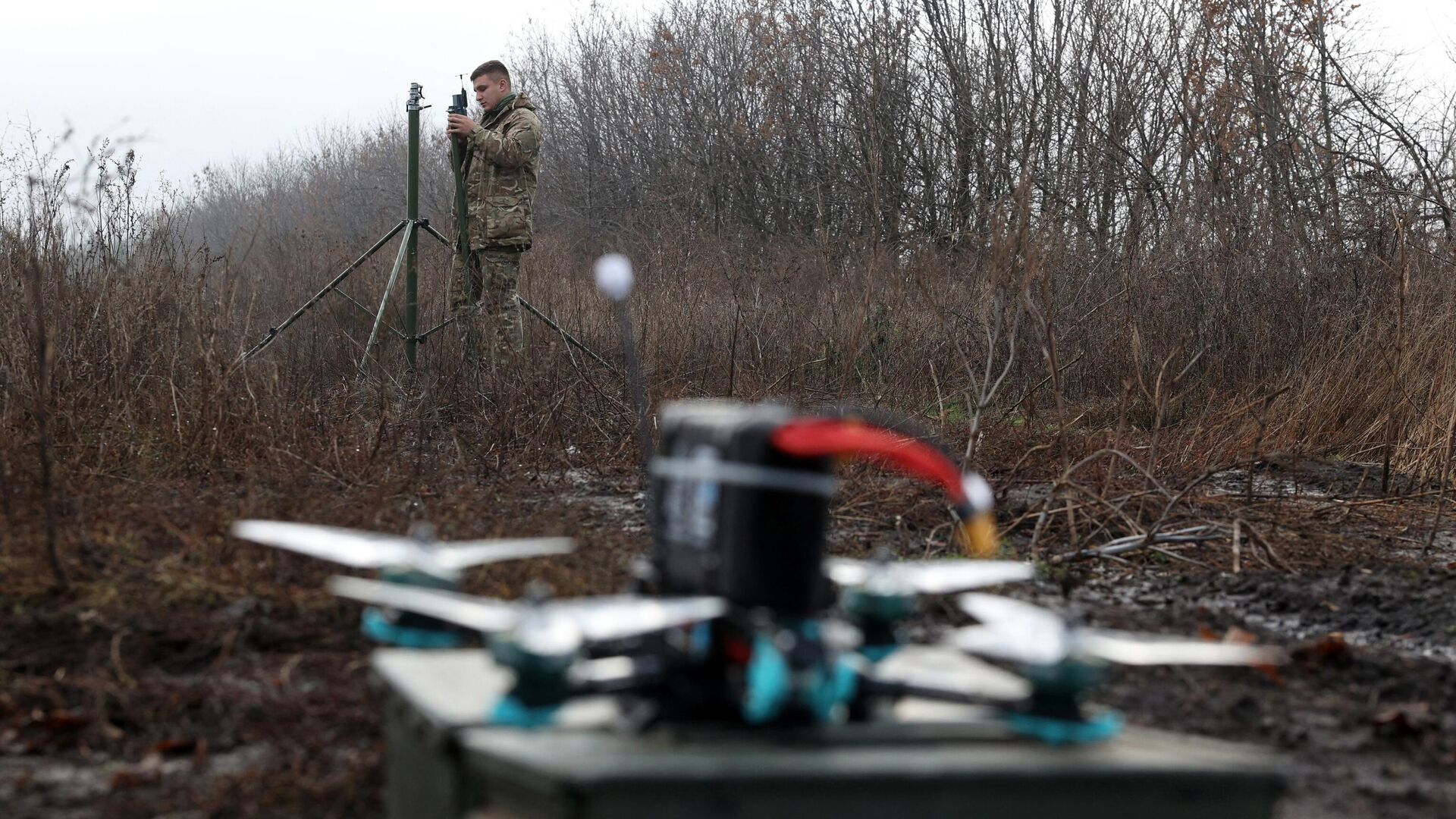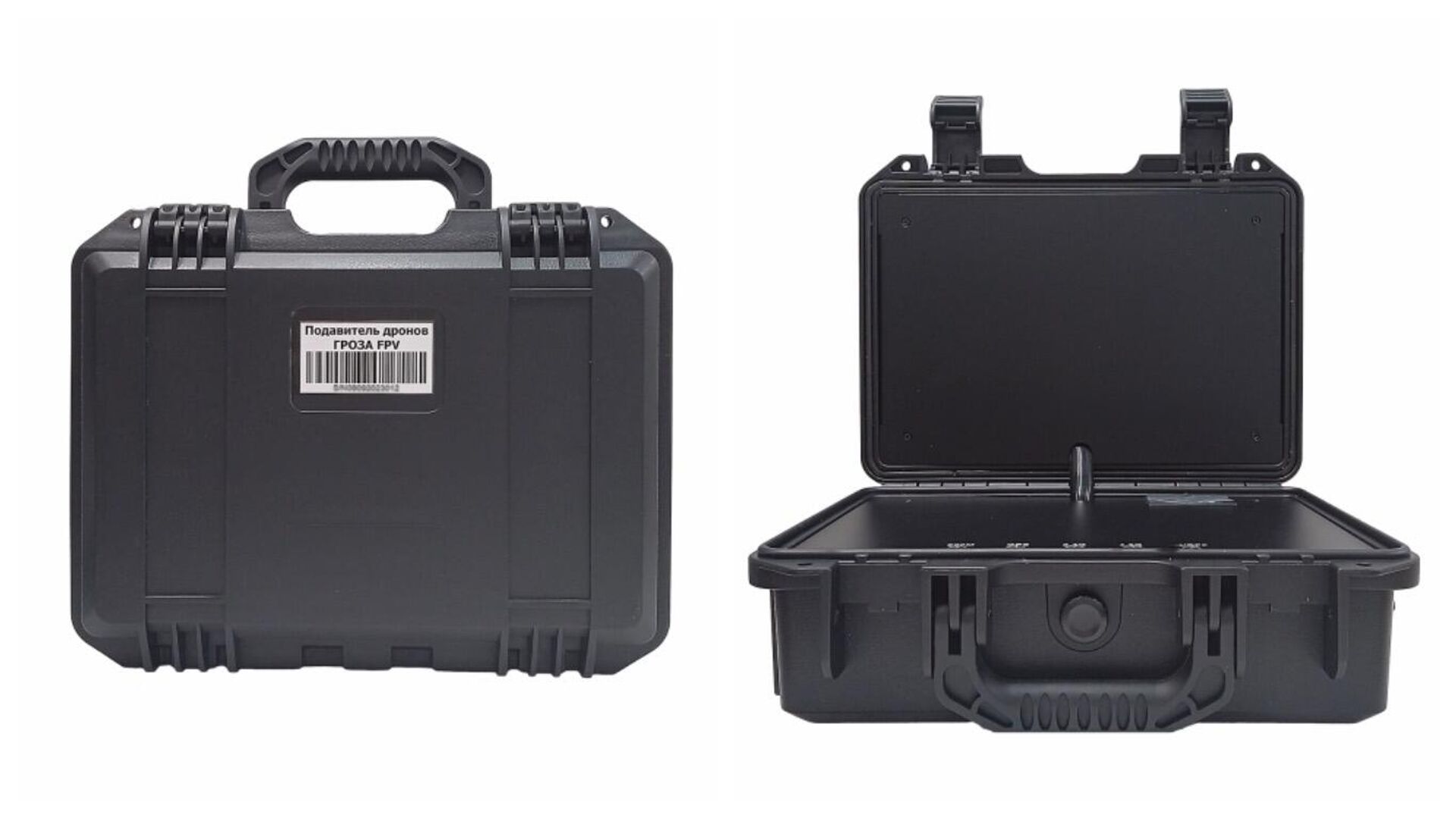https://sputnikglobe.com/20240306/what-we-know-about-russias-new-groza04k-man-portable-anti-fpv-drone-system-1117163035.html
What We Know About Russia’s New Groza.04.K Man-Portable Anti-FPV Drone System
What We Know About Russia’s New Groza.04.K Man-Portable Anti-FPV Drone System
Sputnik International
Running low on cash for big, expensive arms purchases for their ongoing proxy war against Russia, NATO planners have turned to the delivery of large numbers of small, cheap, deadly UAVs to Kiev, with first person view (FPV) drones a top priority. Sputnik looks at a new Russian man-portable complex designed specifically to counter the FPV threat.
2024-03-06T12:45+0000
2024-03-06T12:45+0000
2024-03-06T13:09+0000
military
military & intelligence
russia
ukraine
radio-electronic technologies concern (kret)
nato
kh-101
tomahawk
electronic jammer
jammer technology
https://cdn1.img.sputnikglobe.com/img/07e8/03/06/1117163644_0:162:3063:1885_1920x0_80_0_0_4e1da0402c0232c09a5058d40cc537cd.jpg
Engineers from the Novgorod-based Kvant Research and Production Enterprise have created a new compact, highly portable anti-drone defense system known as the Groza.04.K (lit. "Thunderstorm.04.K") to fight enemy FPV UAVs – a new class of drones used for kamikaze attacks, bombing runs, electronic and optoelectronic reconnaissance, and to serve as decoys to friendly radar and missile systems during enemy attacks.Making use of communication channels resistant to many conventional forms of electronic warfare, FPV drones are a highly dangerous addition to the Ukrainian battlespace. That makes the development and production of tools to fight them essential to preserve lives and equipment.Mass production of the Groza.04.K is said to have already begun, with Russian defense giant Rostec confirming that “the first batch has already been sent to the troops.”How Does the Groza.04.K Operate?According to Kondrashov, the new anti-drone system features “unique design solutions.” Rostec has not elaborated on the Groza.04.K’s capabilities or principles of operation, but published photos of the system’s case, a toolbox-sized black plastic container, indicating that the complex is portable enough to be toted around in a vehicle or on foot by a single trooper.But first, it’s important to mention what makes FPV drones deadly: this particular type of unmanned aerial vehicle has a short range (10-20 km in the best of conditions), is highly maneuverable, and flies at high speeds at low altitudes. The drones are operated using analog signals – the same technology used to broadcast to 20th century televisions.That makes it difficult for many traditional radio and electronic warfare jamming systems – designed to take on big, bulky, high-tech, multi-million dollar weapons systems such as missiles, aircraft, and helicopters operating on military frequencies, to target these particular drones. Their cost (as low as $500 apiece for homemade FPV UAV variants), also makes creating customized, costly missile or other weapons systems to try to intercept them a moot point.This doesn’t mean FPV drones are invisible. According to publicly available information, these UAVs’ signals are typically transmitted in the 5.8GHz range, meaning if channels across this frequency could be jammed, so too could the signals they send back to operators. By some accounts, it’s also possible to jam FPV drones’ 1.2GHz or 2.4GHz control signals, particularly if the jamming unit can precisely target the radio band being used, resulting in the UAVs missing their intended targets and/or returning to failsafe positions.In the event that drone operators attempt to hop frequencies from one band to another, a military-grade jammer should be able to extend the range of coverage across all available frequencies. Flying budget FPV drones also requires that the transmitter antenna and receiver antennas maintain visual contact, so if something can be done about that, it should be possible to put them out of action.Because the Groza.04.K is apparently portable enough to be carried around in a vehicle or on foot, targeting it before engaging in FPV drone attacks should be more difficult.The Groza.04.K’s power consumption is unknown. On the battlefield, even the best, military-grade jammers can overheat, and will require batteries for mobile operation. If the new system can be plugged into a continuous source of power, its ability to operate round the clock will increase.Another possible issue is the sheer size of the Ukrainian battlespace, which naturally means that the larger the number and range of jammers available, the better.What's Important to Know About the Groza.04.K’s CreatorsFounded in 1958, Kvant has a well-established reputation as one of Russia’s leading creators and manufacturers of ground-based electronic reconnaissance and electronic suppression systems, developing over 30 types of specialized military equipment, including the 1L269 multifunctional mobile jamming module (better known as the Krasukha-2, lit. "Beauty-2") and the 1L267 Moskva-1 mobile radio-electronic warfare system.During the Soviet period, along with the production of electronic warfare equipment, Kvant created an array of high-tech civilian products, including televisions and radio receivers. Given FPV drones’ use of this dated 20th century technology, it can’t be ruled out that the company’s engineers were able to take advantage of their extensive knowledge in the field to help create the new FPV UAV jamming tool.Kvant is part of a big family of Russian military radio-electronics firms, with its parent company, KRET (Russian acronym for "Concern Radio-Electronic Technologies"), a domestic radio-electronic warfare powerhouse, developing large, long-range ground-based jammers and radar systems, small jamming systems that can be attached to Su-34 fighters and Ka-52 helicopters, and EW systems for cruise missiles like the Kh-101 and Kh-102. In 2018, after the US, UK, and France launched aerial aggression against Syria, KRET’s engineers were able to obtain unexploded Tomahawk cruise missiles, analyzing them to help develop new electronic warfare systems.
https://sputnikglobe.com/20240224/regular-units-for-use-of-drones-created-in-russian-armed-forces-1116950728.html
https://sputnikglobe.com/20240215/what-are-russias-top-5-anti-satellite-systems-1116802215.html
https://sputnikglobe.com/20240105/russian-electronic-warfare-troops-detect-over-2-mln-airborne-targets-in-2023-1115989760.html
russia
ukraine
Sputnik International
feedback@sputniknews.com
+74956456601
MIA „Rossiya Segodnya“
2024
News
en_EN
Sputnik International
feedback@sputniknews.com
+74956456601
MIA „Rossiya Segodnya“
Sputnik International
feedback@sputniknews.com
+74956456601
MIA „Rossiya Segodnya“
what is russia's groza fpv drone jammer, what tools does russia have to jam fpv drones
what is russia's groza fpv drone jammer, what tools does russia have to jam fpv drones
What We Know About Russia’s New Groza.04.K Man-Portable Anti-FPV Drone System
12:45 GMT 06.03.2024 (Updated: 13:09 GMT 06.03.2024) Running low on cash for big, expensive arms purchases for their ongoing proxy war against Russia, NATO planners have turned to the delivery of large numbers of small, cheap, deadly UAVs to Kiev, with first person view (FPV) drones a top priority. Sputnik looks at a new Russian man-portable complex designed specifically to counter the FPV threat.
Engineers from the Novgorod-based Kvant Research and Production Enterprise have created a new compact, highly portable anti-drone defense system known as the Groza.04.K (lit. "Thunderstorm.04.K") to fight enemy FPV UAVs – a new class of drones used for kamikaze attacks, bombing runs, electronic and optoelectronic reconnaissance, and to serve as decoys to friendly radar and missile systems during enemy attacks.
Making use of communication channels resistant to many conventional forms of electronic warfare, FPV drones are a highly dangerous addition to the Ukrainian battlespace. That makes the development and production of tools to fight them essential to preserve lives and equipment.
Mass production of the Groza.04.K is said to have already begun, with Russian defense giant Rostec confirming that “the first batch has already been sent to the troops.”
The Groza.04.K kit was created in record time, with Kvant General Director Andrey Kondrashov saying the task to design a portable anti-FPV system was set in August 2023, with the system built and delivered to the Defense Ministry for trials in the special military operation by the fall.

24 February 2024, 10:38 GMT
How Does the Groza.04.K Operate?
According to Kondrashov, the new anti-drone system features
“unique design solutions.” Rostec has not elaborated on the Groza.04.K’s capabilities or principles of operation, but published
photos of the system’s case, a toolbox-sized black plastic container, indicating that the complex is portable enough to be toted around in a vehicle or on foot by a single trooper.
Since the anti-drone complex’s capabilities are unknown, the contents of Kvant’s little black box can only be guessed at. What is known is that FPV drones have a few weak spots which talented radio-electronics engineers can exploit, with the tools available depending on the conditions in which they are used.
But first, it’s important to mention what makes FPV drones deadly: this particular type of unmanned aerial vehicle has a short range (10-20 km in the best of conditions), is highly maneuverable, and flies at high speeds at low altitudes. The drones are operated using analog signals – the same technology used to broadcast to 20th century televisions.
That makes it difficult for many traditional radio and electronic warfare jamming systems – designed to take on big, bulky, high-tech, multi-million dollar weapons systems such as missiles, aircraft, and helicopters operating on military frequencies, to target these particular drones. Their cost (as low as $500 apiece for homemade FPV UAV variants), also makes creating customized, costly missile or other weapons systems to try to intercept them a moot point.

15 February 2024, 16:31 GMT
This doesn’t mean FPV drones are invisible. According to publicly available information, these UAVs’ signals are typically transmitted in the 5.8GHz range, meaning if channels across this frequency could be jammed, so too could the signals they send back to operators. By some accounts, it’s also possible to jam FPV drones’ 1.2GHz or 2.4GHz control signals, particularly if the jamming unit can precisely target the radio band being used, resulting in the UAVs missing their intended targets and/or returning to failsafe positions.
In the event that drone operators attempt to hop frequencies from one band to another, a military-grade jammer should be able to extend the range of coverage across all available frequencies. Flying budget FPV drones also requires that the transmitter antenna and receiver antennas maintain visual contact, so if something can be done about that, it should be possible to put them out of action.
Because the Groza.04.K is apparently portable enough to be carried around in a vehicle or on foot, targeting it before engaging in FPV drone attacks should be more difficult.
The Groza.04.K’s power consumption is unknown. On the battlefield, even the best, military-grade jammers can overheat, and will require batteries for mobile operation. If the new system can be plugged into a continuous source of power, its ability to operate round the clock will increase.
Another possible issue is the sheer size of the Ukrainian battlespace, which naturally means that the larger the number and range of jammers available, the better.

5 January 2024, 13:52 GMT
What's Important to Know About the Groza.04.K’s Creators
Founded in 1958, Kvant has a well-established reputation as one of Russia’s leading creators and manufacturers of ground-based electronic reconnaissance and electronic suppression systems, developing over 30 types of specialized military equipment, including the 1L269 multifunctional mobile jamming module (better known as the
Krasukha-2, lit. "Beauty-2") and the 1L267 Moskva-1 mobile radio-electronic warfare system.
During the Soviet period, along with the production of electronic warfare equipment, Kvant created an array of high-tech civilian products, including televisions and radio receivers. Given FPV drones’ use of this dated 20th century technology, it can’t be ruled out that the company’s engineers were able to take advantage of their extensive knowledge in the field to help create the new FPV UAV jamming tool.
Kvant is part of a big family of Russian military radio-electronics firms, with its parent company, KRET (Russian acronym for "Concern Radio-Electronic Technologies"), a domestic radio-electronic warfare powerhouse, developing large, long-range
ground-based jammers and radar systems, small jamming systems that can be attached to
Su-34 fighters and
Ka-52 helicopters, and EW systems for
cruise missiles like the Kh-101 and Kh-102. In 2018, after the US, UK, and France launched aerial aggression against Syria, KRET’s engineers were able to obtain unexploded Tomahawk cruise missiles,
analyzing them to help develop new electronic warfare systems.







